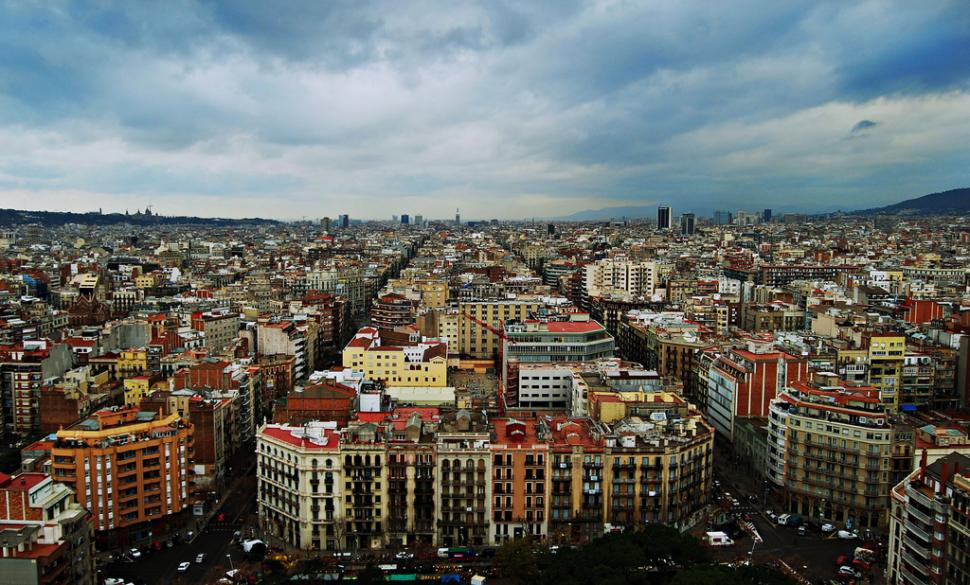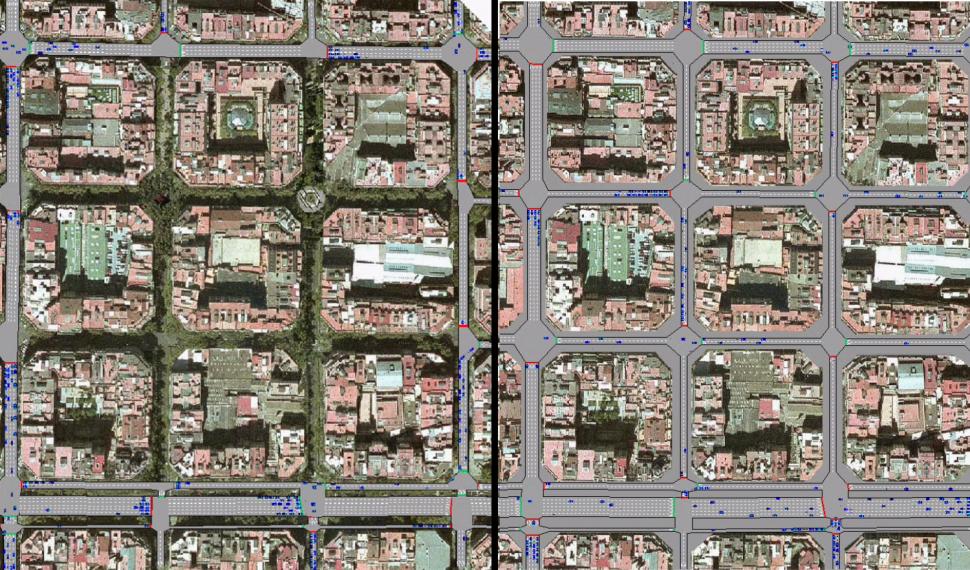- News
- Reviews
- Bikes
- Accessories
- Accessories - misc
- Computer mounts
- Bags
- Bar ends
- Bike bags & cases
- Bottle cages
- Bottles
- Cameras
- Car racks
- Child seats
- Computers
- Glasses
- GPS units
- Helmets
- Lights - front
- Lights - rear
- Lights - sets
- Locks
- Mirrors
- Mudguards
- Racks
- Pumps & CO2 inflators
- Puncture kits
- Reflectives
- Smart watches
- Stands and racks
- Trailers
- Clothing
- Components
- Bar tape & grips
- Bottom brackets
- Brake & gear cables
- Brake & STI levers
- Brake pads & spares
- Brakes
- Cassettes & freewheels
- Chains
- Chainsets & chainrings
- Derailleurs - front
- Derailleurs - rear
- Forks
- Gear levers & shifters
- Groupsets
- Handlebars & extensions
- Headsets
- Hubs
- Inner tubes
- Pedals
- Quick releases & skewers
- Saddles
- Seatposts
- Stems
- Wheels
- Tyres
- Health, fitness and nutrition
- Tools and workshop
- Miscellaneous
- Tubeless valves
- Buyers Guides
- Features
- Forum
- Recommends
- Podcast
 Barcelona blocks - image CC licensed via shawnleishman on Flickr.jpg
Barcelona blocks - image CC licensed via shawnleishman on Flickr.jpgBarcelona plans to cut cars from 60% of city steets
Barcelona is the latest European city to look towards cutting road traffic in a bid to tackle air pollution and promote a more sustainable city centre environment.
The goal of cutting inner city road traffic by 21%, and in the process freeing up nearly 60% of the city's streets, is laid out in the council's new mobility plan; which also includes plans for 300km of inner city bicycle lanes.
That plan covers a number of facets, including road safety, sustainable transport, social cohesion and inclusion, as well as cutting chemical emissions, noise emissions and many of the inefficiencies in the transport system.
Most important are the introduction of superblocks, which look to limit traffic to arterial routes, around an area of nine-or-so existing blocks. This will open up smaller streets to bicycles, pedestrians and business vehicles, cultivating growth of green, safe, community spaces.
The city was originally engineered with open green spaces in mind, especially in the blocky Eixample neighbourhood outside of the old city walls pictured above.
Legendary engineer Ildefons Cerdà laid out his grid-system expansion plan for Barcelona in the 19th century as the city outgrew its restricting walls, wherein he also calculated the volume of atmospheric air one person needed to breathe correctly.
However, 200 years of modernisation and industrialisation later, and the city has changed. Cerdà's calculations - which quantified the first venture into the study of urbanisation - are less relevant, and those open urban spaces he imagined are now choked with cars and full of noise.
It is estimated that air pollution causes 3,500 premature deaths in Barcelona's metropolitan area per year - out of a population of 3.2 million - as the city and its 35 surrounding municipalities have consistently failed to meet EU air quality targets.
With all this talk of poor air conditions you may think that Barcelona isn't a cycling city; you'd be wrong. Bicycle culture magazine Copenhagenzine rated Barcelona as the third-best European city for cycling in 2011, and Bicing - what we call bicycle hire schemes - started in Barcelona in 2007, three years before then-mayor Ken Livingstone brought his bikes to our capital.
The Catalunyan city has since dropped to 11th in Copenhaganzine's index. Though not hugely worrying for the Spanish city, the magazine rating is an indication - as are the years of missing EU air quality guidelines - that things are no longer as rosy in the Spanish city for cyclists.
Which is why this proposal is so welcome.
In recent months we've seen city's like Oslo announcing plans to cut traffic from their city centres entirely, but Barcelona's plan is not an outright ban on cars, rather a controlled confinement of road traffic.
The idea is to introduce superblocks, which are an urban planning phenomenon from the mid-20th century which considered pedestrian and cyclists as obsolete modes of transportation in favour of the new automobile.
Obviously the superblocks we're discussing here have been reimagined for modern day Barcelona.
The superblocks proposed by BCNecologia, Barcelona's agency of ecological urbanisation, centre around the concept of restricting cars to arterial routes, while leaving the smaller - often one way - streets clear for pedestrians and cyclists.
In an area like Eixample a superblock will contain nine blocks. The plan won't leave anyone further than 300 meters from a bus stop, with significantly reduced waiting times due to significantly reduced traffic light-controlled junctions.
The hope is that this will help areas of the city discover an even clearer individual sense of cultural identity.
Janet Sanz, the city councillor for ecology, urbanism, and mobility spoke to the Guardian about her plan to "win the streets back."
"This plan sums up the essence of urban ecology.
“Our objective is for Barcelona to be a city in which to live. Also, as a Mediterranean city, its residents spend a long time on the streets – those streets need to be second homes, or extensions of one’s residence, at all times.
"Public spaces need to be spaces to play, where green is not an anecdote – where the neighbourhood’s history and local life have a presence.
"We need to win the street back."
Sanz also told the Guardian that the plan is being implimented in nine different areas at differing paces in something of a trial and error method which they are calling "tactical urbanism."
The project's budget is an initial €10m, and the first steps will be low level things, such as changing road signs.
Ms Sanz is confident though, saying that now is the time to "go from theory to action."
Latest Comments
- wtjs 4 min 32 sec ago
I'd love to know the outcome of this one...
- Steve K 9 min 14 sec ago
Yeah, but other than that, no real difference.
- panda 20 min 9 sec ago
I know it's not really what the article is about (i.e. minority interest groups trying to exert disproportional influence over planning decisions -...
- Seagull2 1 hour 7 min ago
I have an almost 20 yr old Brompton, the best "toy" i ever bought. Of course , i covet a new G line, but likely will have to wait for a roundy...
- Rendel Harris 1 hour 33 min ago
For £3.50 more on Amazon you can get the earlier version of this light which doesn't have the white light option or magnetic fixing but does have a...
- FionaJJ 1 hour 52 min ago
It's so frustrating, and as you say, there is the potential for the police to get a lot of bang for their buck by taking advantage of the work done...
- Miller 2 hours 3 min ago
I have done a lot of road riding with my Ekar-equipped bike, normally set up as 40 x 9-42. My conclusion is that 13 speeds is indeed enough for...
- David9694 3 hours 40 min ago
Whitley Bay pub suffers bad start to 2025 after car crashes into it on New Year's Day...

Add new comment
8 comments
The roads in central Barcelona are perfect for cycling, from what I saw during my two visits there. Smooth tarmac roads and cycle lanes either in the middle of the wider roads, like Parrallel or armadillo'd lanes elsewhere.
IMG_20150915_203113636.jpg
Valencia - just down the coast from Barcelona - is also moving in the same direction. One of the reasons that (most) Spanish drivers overtake cyclists with more care than British drivers is that the law is clear: drivers must leave 1.5 metres of space. The UK Highway Code requirement is much too vague: 'at least as much space as a car'.
I am looking forward to this.
Driving in Barcelona is such a pointless activity. There is no parking available, so all you do is driving around in circles.
I don't really need more cycling lanes, but having more green space in the city is brilliant. And it is great for walking and having space for children to play.
We will still have to see how much of this is implemented, but I imaging that flat prices in these areas are already going up.
Another plan is to have more "Ramblas", which are wider roads with a central area for walking, speed and access for cars on these is also limited.
Maybe the future is looking good after all.
Is the EU Debate the new Helmet Debate?
I spent a couple of days riding there last week at the end of a Paris to Barcelona tour - they have some pretty decent cycle infrastructure already, I particularly liked the central lanes on busier roads.
The thing that struck me, much like riding in Amsterdam, was drivers respect for cyclists - not all their roads have cycle lanes and when I was mixing it with the traffic I didn't have a single close pass, threateningly revved engine or horn sounded. Drivers just showed patience and courtesy and that to me explains Barcelona's high ranking in the survey.
I'm back in the UK now, where doubtless this happy bubble will be burst within a few pedal strokes of city riding.
Not sure why not being in EU would stop us using ideas from abroad? Is this because you believe no one wil travle any more ?!
Many of Eixample's and other barrios of Barcelona's streets are too narrow for cars realistically anyway. This is a great idea from a great city, although it is already a pretty easy place to cycle in , due to good cycle routes and lots of back route cycle-friendly paths.
I happily cycled every day for the year and a half I was there. The Bicing bikes were much the quickest way around the city when the metro got too hot in summer.
...and this is why Britain should remain in Europe. Our politicians are rubbish when it comes to conceiving and implimenting radical ideas. This idea carries form and function when our local councils fritter money away by commissioning sculpures and silly monuments and rushed through ideas which may not even see the light of day but most of the money has been spent on consultantancy fees.
Where has all of the out of the box thinking gone in Britain. We no longer innovate and lead the way. We sit back, see what the rest of the world comes up with, then wait to see what the reaction is, think about copying it but balls it up in the process.
Napolean was right. We are a nation of shop keepers...and shoppers too. Oh, and administrators. Engineers and innovators? Pah, not likely.
Sounds like a great idea, they should go ahead asap before frothing at the mouth petrolheads start moaning too much.